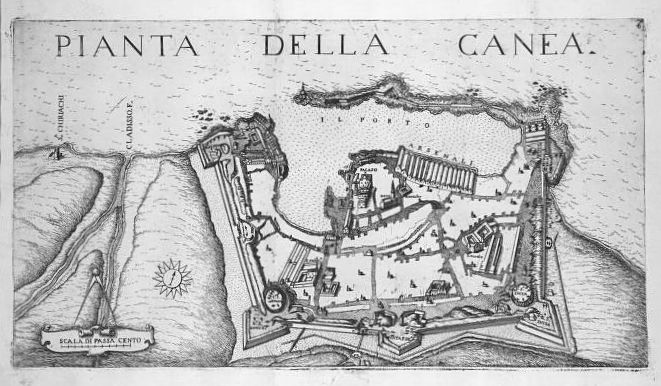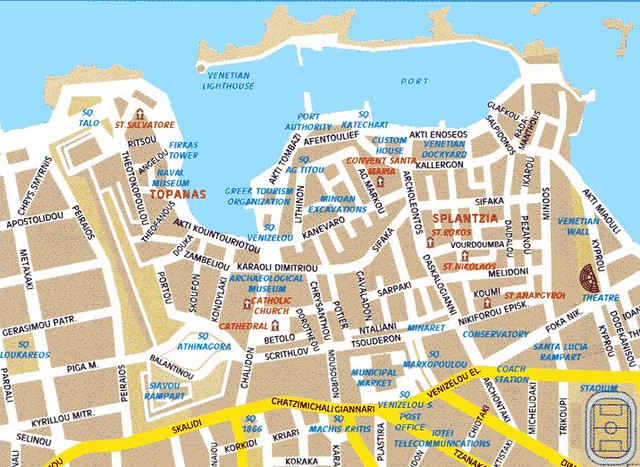 |
| Map of Hania, 1651 - the town was known by a number of names including Kydonia and Canea. |

Haniotika Nea, 29/9/2012 - the Kydonia excavations in the old town hint at the town's age.


It is only in recent times that tourism has become a popular activity that many people can take part in; in the past, it was not easy to travel for the purposes of having foreign experiences, nor was it easy to disseminate travel experiences in the way that it is nowadays, but even the minority at the time which did have access to travelling beyond the borders of their own countries often kept records of their experiences, which have found their way into modern texts. Those early travellers - some drew, others wrote - left us a hint of what Crete was like in the past.
 A 2003 Greek publication compiled by Mihalis Grigorakis records the accounts left by 35 European travellers to Crete, and Hania in particular, from the 15th to the 17th centuries. Even though
Iraklio is a larger town than Hania, it was Hania that European
travellers in older times often arrived in first, when landing in Crete,
since Hania was located on a direct route from West to East (via the islands of Kithira and Gramvousa), Iraklio
being located further east than Hania. Before Crete joined the Greek state, foreign embassies had their headquarters in Hania, since it was also regarded as the the capital of Crete (it held this status until 1971 when Iraklio was named as the capital).
A 2003 Greek publication compiled by Mihalis Grigorakis records the accounts left by 35 European travellers to Crete, and Hania in particular, from the 15th to the 17th centuries. Even though
Iraklio is a larger town than Hania, it was Hania that European
travellers in older times often arrived in first, when landing in Crete,
since Hania was located on a direct route from West to East (via the islands of Kithira and Gramvousa), Iraklio
being located further east than Hania. Before Crete joined the Greek state, foreign embassies had their headquarters in Hania, since it was also regarded as the the capital of Crete (it held this status until 1971 when Iraklio was named as the capital). This compilation provides a fascinating account of how the town and its inhabitants were viewed by a number of European travellers (the memoirs of each traveller have been translated into Greek). The accounts of some of those travellers read like a modern blog, hinting at the origins of our fascination with the strange, the foreign, the exotic. Some of the memoirs are simple accounts; others contain details of adventure and crime.

The first account is that of Cristoforo Buondelmonti (1386–c.1430), an Italian monk, traveler and pioneer in promoting first-hand knowledge of Greece and its antiquities throughout the Western world. His description of Hania in 1412 gives us a hint of climate change over the years, and it confirms the fertility of the area:
Onorio Belli from Vicenza of Italy was a doctor and botanist, who stayed in Crete for a long time and amassed a large amount of research on the island. While he was in Hania, he experienced a large earthquake on the 16th of November (in 1593, from what I understand):"Finally, a port appears, a very old one, behind which we see the town of Kydonia... We enter this town, where a kindly old man explains everything around us: Do you see that hilly bulk, the very high one? That is the Lefka Ori, which dominate our town and they are found so close to us. All year round they are covered in snow. It is from there that the river of Kladissos is filled. It passes through cavernous valleys, descending craggy heights it reaches this very fertile valley. Here the residents divide the current of the river into a large number of irrigation channels and they produce various foodstuff, with an abundance of vegetables in particular. Look to the right, those uncountable orchards with the orange and citrus trees as well as the fruit-bearing trees through the whole extent of the valley. To the east, you clearly discern vineyards, which yield a highly reputed reddish wine, and very lucratively cultivated fields."
Kladissos River with Lefka Ori in the horizon
Despite the year-round snowy peaks of Lefka Ori (= Λευκά Όρη, White Mountains) as reported by Cristoforo Buondelmonti, Onorio Belli claims that it rarely rained when he was here, causing food shortages:"The atmosphere was calm and clear and the sea peaceful when we suddenly heard a buzzing and felt a jolt, as if 15 to 20 carriages were running together over a rocky road with a wheezing sound in the air, a crunching sound on earth and a crashing sound in the houses, scrambled together with mist, dust and smoke, that came out of the ruins of the fallen walls. All this I cannot name without likening them to a real hell ..."
The sea as viewed from close to the Lefka Ori
One of the more eccentric accounts would have to be that of the Rare Adventures & Painful Peregrinations By William Lithgow, a Scot who visited Hania in 1614, whose original writings have remained to this day, written in an old English spelling style. He was involved in a a number of skirmishes with the Venetians from the moment he set foot on the island, claiming that he had been beaten, robbed and starved. He describes the landscape as being green and rocky:"The reason for this earthquake in my opinion could be found in the excessive aridness that exists in the autumn and winter. November was much hotter than August, and even now it is warmer on average in March, and it didn't rain until the 6th of December last year. This was viewed as terrifying, because they had not yet begun sowing the fields, something considered unusual in this climate... If it rains a few times and they sow the fields, since March hasn't finished yet and in April it rains two or three times, it will be good. But if the dry weather continues, people will die of hunger. Here is a great lack in all things. Wheat is 6 pounds a bushel, quite unusual because in other years it was 3. Meat is not to be found, because the dry weather made all the animals die of hunger, because it is common to maintain animals in the countryside where they eat grass throughout the winter, which grows with the rains in October."
Summers are often terracotta-dry here.
The accounts all generally attest to Hania's fertile soil, mild climate and beautiful landscape, which have all helped to continuously maintain a population in the town until the present day."Southwest... lieth a pleasant plaine surnamed the Valley of Suda... I discended to crosse the Valley, and passe the haven, me thought the whole planure resembled a greene sea; and that was onely by reason of infinite Olive trees grew there, whose boughes and leaves over-toppe all other fructiferous trees on the plaine: The Villages for losse of ground are built on the skirts of Rockes, upon the South side of the Valley; yea, and so difficile to climbe them, and so dangerous to dwell in them, that me thought their lives were in like perill, as he who was adjoyned to sit under the point of a two handed sword, and it hanging by the haire of a horse tayle. Trust me, I told along these Rockes at one time, and within my sight, some 67 Villages, but when I entred the valley, I could not find a foote of ground unmanured, save a narrow passing way wherein I was: The Olives, Pomegranets, Dates, Figges, Orenges, Lemmons and Pomi del Adamo (tomatoes?) growing all through other: And at the rootes of which trees grew: Wheate, Malmsie (grapes), Grenadiers, Carobiers (carob plants?), Mellones, and all other sorts of fruites and hearbes, the earth can yeeld to man; that for beauty, pleasure, and profit it may easily be surnamed, the garden of the whole Universe, being the goodliest plot, the Diamond sparke, and the Honny spot of all Crete."
Fruit orchard in Souda, near the port
©All Rights Reserved/Organically cooked. No part of this blog may be reproduced and/or copied by any means without prior consent from Maria Verivaki.





No comments:
Post a Comment